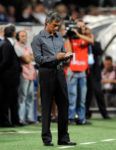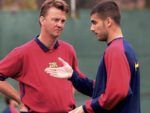Plenty of football stadiums have statues standing outside of them. There’s strange one here and there (Michael Jackson formerly outside Craven Cottage springs to mind, looking like a cheap toy from a Happy Meal) but most are what you would expect: legendary managers, team captains, record goalscorers. One statue that may strike you as unexpected can be found outside the Maksimir Stadium in Zagreb, Croatia, home to Dinamo Zagreb. It depicts neither player nor manager, but rather three soldiers. The inscription reads: “to the fans of the club, who started the war with Serbia at this ground on May 13th, 1990”. It is a reference to the events of a football match in which the game took a back seat and Zvonimir Boban took centre stage – with a kick that started a war.
First, some background. By the time that now-infamous match between Boban’s Dinamo Zagreb and Red Star Belgrade took place, Yugoslavia was already perched on the brink of the abyss of war it would sink into for the next five years. The Republic of Croatia had held elections a month before the game and pro-independence candidate Franjo Tujdman was the victor. Tujdman and his allies, familiar with the moderate, urbanite Serbs living in the big Croatian cities like Zagreb, fatally underestimated the reaction of Serbs elsewhere in the country who saw Tujdman’s victory as a threat to their way of life. Indeed, there had been a media campaign waged from Belgrade which claimed that the Serbs in Croatia lived under the threat of genocide. This propaganda served only to stir up ethnic tensions which hardly needed stirring: many Serbs in Croatia already saw Tujdman’s unapologetic Croatian nationalism as a creeping fascism. During Tito’s reign in charge of Yugoslavia, national political rights were suppressed – Croat, Serb, Montenegrin, Albanian, Bosnian, Muslim, Kosovan, Macedonian, Slovene; all were subsumed under the all-encompassing Yugoslav state, and so after Tujdman’s victory, many Croatians were looking to a new era for their state. Croat nationalism came out of hiding; the sahovnica (the red and white heraldic shield, now the makeup of the Croatian football kit) flag was hung from buildings, Croat replaced Serbian as the language of the state and large numbers of Serbs were made redundant as nationality became a criteria for employment (previously Serbs in Croatia made up around 12% of the population but held almost 18% the official positions).
Tujdman’s pro-independence and pro-nationalist stance saw Croatia at loggerheads with Serbia and Slobodan Milosevic, head of the Serbian Communist Party. Milosevic promoted centralism and believed in the continuation of a unified Yugoslavia, controlled by Serbs. Milosevic had already reasserted his control over the former autonomous regions of Kosovo and Vojvodina but Croatia, Slovenia and Bosnia, all of whom desired more autonomy if not full independence, would not be so easily brought to heel. As a result tensions simmered throughout 1990 and war seemed inevitable.
Ongoing political tensions did nothing to stop the Yugoslavian football league, which featured teams from every republic in Yugoslavia. Therefore May 13th of 1990 saw Belgrade’s Red Star travel to Zagreb to face Dinamo at the Maksimir Stadium. Both sets of fans featured a violent, hardcore ultra element. Red Star’s ultras were known as the Delije, led by the vicious Serbian warlord Zeljko Raznatovic – better known as Arkan, while Dinamo’s violent element were known by the Anglicised name of Bad Blue Boys (BBB). Clashes between the two groups were nothing new and the conflict at Maksimir seemed premeditated rather than spontaneous. Clashes started outside the ground, on the streets of Zagreb but continued inside the ground and on the pitch. Accounts of what actually happened tend to differ, but it seems that the Delije began chanting “Zagreb is Serbian” before tearing up seats and throwing them at fans. At some stage home fans (or, depending on the account you read, “neutral” fans of Rijeka) began tearing down Red Star banners and both sets of fans charged on to pitch toward one another, security doing little or nothing to prevent the clashes.
![]()
The Red Star players soon exited the pitch and the stadium, but many of the Dinamo players stayed behind, setting the stage for Boban’s iconic moment. The then 21-year-old midfielder and club captain saw a Dinamo fan being attacked by a police offer and launched a flying kick at him, knocking him down and allowing the fan to escape. The moment was captured on camera and soon Boban became a Croat folk hero, a symbol for all they were fighting for. Boban found himself suspended by the Yugoslav FA for 9 months, missing the 1990 World Cup and was vilified across Serbia, though he soon moved away anyway, joining AC Milan in 1991. Though despite an illustrious career, for many the most important thing Boban did in his career involved kicking a police officer, not a ball.
The riots in Zagreb and the Maksimir stadium are seen by many as the unofficial start of the Croatian War of Independence, one of the many conflicts to make up the Yugoslav Wars which raged between 1990 and 1995, the deadliest conflict in Europe since World War II. It’s believed around 140,000 thousand people lost their lives during the wars, and over 2 million people displaced. Boban could never have known that a spur-of-the-moment kick to defend one of his own would have been a precursor to such events, but a football match proved to be a divining rod for events to come. The game of May 13th, 1990 proved that for better or worse, football can be more than a game.









Recent Comments